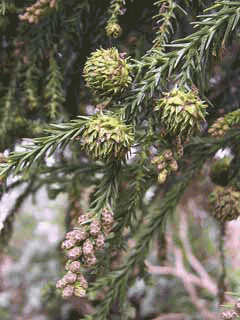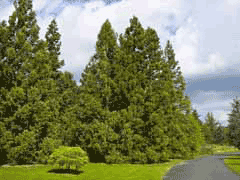 |
|
http://commons.wikimedia.org/wiki/User:B.navez |
 |
|
Translate this page:
Summary
Form: Oval, Pyramidal.
Physical Characteristics

 Cryptomeria japonica is an evergreen Tree growing to 20 m (65ft) by 8 m (26ft) at a fast rate.
Cryptomeria japonica is an evergreen Tree growing to 20 m (65ft) by 8 m (26ft) at a fast rate.
See above for USDA hardiness. It is hardy to UK zone 6. It is in leaf all year, in flower from February to March, and the seeds ripen from October to March. The species is monoecious (individual flowers are either male or female, but both sexes can be found on the same plant) and is pollinated by Wind.
Suitable for: light (sandy), medium (loamy) and heavy (clay) soils. Suitable pH: mildly acid, neutral and basic (mildly alkaline) soils and can grow in very acid soils.
It cannot grow in the shade. It prefers moist soil. The plant can tolerates strong winds but not maritime exposure.
UK Hardiness Map
US Hardiness Map
Synonyms
C. fortunei. Cupressus japonica.
Plant Habitats
Woodland Garden Canopy;
Edible Uses
References More on Edible Uses
Medicinal Uses
Plants For A Future can not take any responsibility for any adverse effects from the use of plants. Always seek advice from a professional before using a plant medicinally.
Depurative VD
An oil and/or a resin from the plant is depurative and also used in the treatment of gonorrhoea[218].
References More on Medicinal Uses
The Bookshop: Edible Plant Books
Our Latest books on Perennial Plants For Food Forests and Permaculture Gardens in paperback or digital formats.

Edible Tropical Plants
Food Forest Plants for Hotter Conditions: 250+ Plants For Tropical Food Forests & Permaculture Gardens.
More

Edible Temperate Plants
Plants for Your Food Forest: 500 Plants for Temperate Food Forests & Permaculture Gardens.
More

More Books
PFAF have eight books available in paperback and digital formats. Browse the shop for more information.
Shop Now
Other Uses
Incense Shelterbelt Wood
The leaves are very aromatic and are used as incense sticks[46, 61, 272]. A fairly wind-tolerant tree, it can be used in shelterbelt plantings[200]. Wood - light, fragrant, fine grained[46, 61]. The wood is strongly rot resistant, easily worked, and is used for buildings, bridges, ships, lamp posts, furniture, utensils, and paper manufacture[1, 46, 61, 266]. The wood can be used as a substitute for Deal[146]. Old wood that has been buried in the soil turns a dark green and is then much esteemed[46, 61].
Special Uses
Food Forest
References More on Other Uses
Cultivation details
Landscape Uses:Screen, Specimen, Street tree. Prefers a deep rich moist alluvial soil and a sheltered position in full sun[1, 11, 164]. Tolerates very acid to somewhat alkaline soils, but becomes chlorotic on shallow soils over chalk[200]. Plants are fairly wind-tolerant[200]. A very ornamental tree[1], it has been widely cultivated as a forestry tree for several centuries in Japan and there are many strains each adapted to the various local conditions[11]. Many forms, almost all of them dwarf, have also been selected for their ornamental value[185, 200]. A fast-growing tree on deep, well-drained soils in montane areas with a warm, moist climate, but intolerant of poor soils and cold, drier climates[266]. Occasionally planted for timber in Europe[50], trees do not generally do as well as could be expected in Britain, the best specimens are to be found in the west, especially in the south-west[11]. Trees can grow quite fast in the western part of the country with annual increases of 1 metre or more[185]. New growth takes place from early June to August[185]. Growth decreases rapidly with age, virtually ceasing when the tree reaches 25 metres[185]. This species is notably resistant to honey fungus[200]. Unlike most conifers, this species can be coppiced[81]. Special Features:
Attractive foliage, Not North American native, Inconspicuous flowers or blooms.
References Carbon Farming Information and Carbon Sequestration Information
Temperature Converter
Type a value in the Celsius field to convert the value to Fahrenheit:
Fahrenheit:
The PFAF Bookshop
Plants For A Future have a number of books available in paperback and digital form. Book titles include Edible Plants, Edible Perennials, Edible Trees,Edible Shrubs, Woodland Gardening, and Temperate Food Forest Plants. Our new book is Food Forest Plants For Hotter Conditions (Tropical and Sub-Tropical).
Shop Now
Plant Propagation
Seed - sow early spring in a cold frame. The seed germinates better if given a short cold stratification for 2 - 3 weeks at 4°c and is then placed in a warm position[164]. Germination usually takes place within 3 - 9 weeks at 15°c[164]. When they are large enough to handle, prick the seedlings out into individual pots and grow them on in the greenhouse for at least their first winter. Plant them out into their permanent positions in late spring or early summer, after the last expected frosts. An alternative is to plant out the young trees into an outdoor nursery bed when they are about 8cm tall and grow them on for a couple of years before planting them into their permanent positions in late autumn or early spring[164]. Cuttings in the autumn in a sandy soil in a cold frame.
Other Names
If available other names are mentioned here
Native Range
TEMPERATE ASIA: Japan (Honshu, Kyushu, Shikoku)
Weed Potential
Right plant wrong place. We are currently updating this section.
Please note that a plant may be invasive in one area but may not in your area so it's worth checking.
Conservation Status
IUCN Red List of Threatened Plants Status :

Growth: S = slow M = medium F = fast. Soil: L = light (sandy) M = medium H = heavy (clay). pH: A = acid N = neutral B = basic (alkaline). Shade: F = full shade S = semi-shade N = no shade. Moisture: D = dry M = Moist We = wet Wa = water.
Now available:
Food Forest Plants for Mediterranean Conditions
350+ Perennial Plants For Mediterranean and Drier Food Forests and Permaculture Gardens.
[Paperback and eBook]
This is the third in Plants For A Future's series of plant guides for food forests tailored to
specific climate zones. Following volumes on temperate and tropical ecosystems, this book focuses
on species suited to Mediterranean conditions—regions with hot, dry summers and cool, wet winters,
often facing the added challenge of climate change.
Read More
Expert comment
Author
(L.f.)D.Don.
Botanical References
11200266
Links / References
For a list of references used on this page please go here
Readers comment